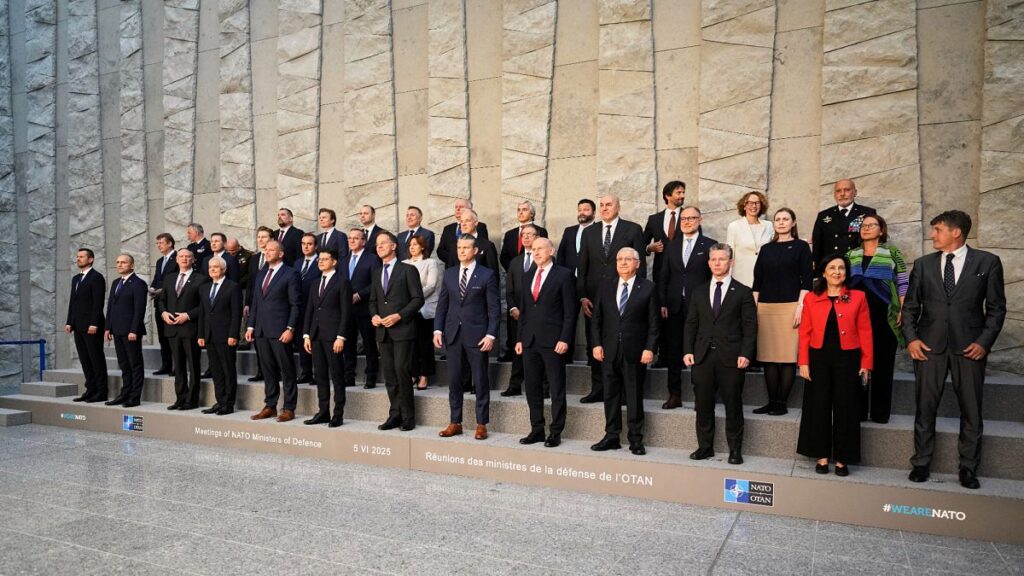Most US allies at NATO have endorsed US President Donald Trump’s demand that they invest 5% of GDP on defence and are ready to ramp up security spending, the alliance’s Secretary General Mark Rutte said on Thursday.
“There’s broad support,” Rutte told reporters after chairing a meeting of NATO defence ministers at the alliance’s Brussels headquarters.
“We are really close,” he said, adding that he has “total confidence that we will get there” by the next NATO summit in three weeks.
European allies and Canada have already been investing heavily in their armed forces, as well as on weapons and ammunition, since Russia launched a full-scale invasion of Ukraine in 2022.
At the same time, some have balked at US demands to invest 5% of GDP on defence; 3.5% on core military spending and 1.5% on the roads, bridges, airfields and sea ports needed to deploy armies more quickly.
Struggling to meet the goal
In 2023, as Russia’s war on Ukraine entered its second year, NATO leaders agreed to spend at least 2% of GDP on national defence budgets.
So far, 22 of the 32 member countries have done so, and others are still struggling to meet the target.
Trump and his NATO counterparts appear likely to endorse the new goal at a summit in The Hague on 24-25 June.
Trump insists that US allies should spend at least 5% so America can focus on security priorities elsewhere, mostly in the Indo-Pacific and on its own borders.
He has gained important leverage over other NATO countries by casting doubt over whether the United States would defend allies that spend too little.
The new goal would involve a 1.5% increase over the current 2% goal for defence budgets. It means that all 32 countries would be investing the same percentage.
The United States spends by far more than any other ally in dollar terms.
But according to NATO’s most recent figures, it was estimated to have spent 3.19% of GDP in 2024, down from 3.68% a decade ago. It’s the only ally whose spending has dropped since 2014.
While the two new figures do add up to 5%, factoring in improvements to civilian infrastructure so that armies can deploy more quickly significantly changes the basis on which NATO traditionally calculates defence spending.
The seven-year time frame is also short by the alliance’s usual standards. The far more modest 2% target, set after Russia annexed Ukraine’s Crimean Peninsula in 2014, was meant to be reached over a decade.
US leadership at NATO
According to US Defence Secretary Pete Hegseth, Trump has done nothing less than save NATO.
He told reporters that European allies around the table on Thursday had said: “We hear you. We all need increased capabilities. We all need to spend more. Thank you, President Trump, for reviving this alliance. It was an alliance that was sleepwalking to irrelevance.”
The extra spending will also be needed should the Trump administration announce a force draw down in Europe, where around 84,000 US troops are based, leaving European allies to plug any security gaps.
Asked what the Pentagon’s plans are, Hegseth did not explain but he said: “It would only be responsible for the United States to continually assess our force posture, which is precisely what we’ve done.”
“America can’t be everywhere all the time, nor should we be and so there are reasons why we have troops in certain places,” he said, offering the assurance that any review would be done “alongside our allies and partners to make sure it’s the right size.”
During the meeting, Hegseth and his defence counterparts also approved purchasing targets for stocking up on weapons and military equipment to better defend Europe, the Arctic and the North Atlantic.
The “capability targets” lay out goals for each of the 32 nations to purchase priority equipment like air defence systems, long-range missiles, artillery, ammunition, drones and “strategic enablers” such as air-to-air refuelling, heavy air transport and logistics.
Each nation’s plan is classified, so details are scarce.
The new targets are assigned by NATO based on a blueprint agreed upon in 2023, the alliance’s biggest planning shakeup since the Cold War, to defend its territory from an attack by Russia or another major adversary.
Under those plans, NATO would aim to have up to 300,000 troops ready to move to its eastern flank within 30 days, although experts suggest the allies would struggle to muster those kinds of numbers.
Read the full article here


